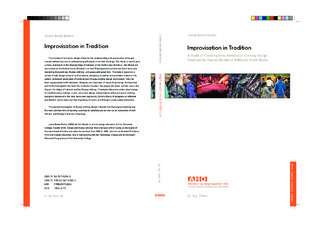Improvisation in tradition
Abstract
The concept of vernacular design allows for the understanding and appreciation of designs created without recourse to institutional qualifi cations in the fi eld of design. This thesis is based upon a study undertaken in the Iñupiaq village of Kaktovik on the North Slope of Alaska – the Iñupiat are also known as North Alaska Inuit (Eskimo) – on how Iñupiaq women practice and learn vernacular designing of present-day Iñupiaq clothing – annuġaaq with qupak trim. The study is based on a review of both design research and vernacular designing, as well as documentation based on the writer’s participant observation of contemporary Iñupiaq clothing design and creation. This has
been supplemented with interviews, dialogues and a process of research-by-design. An important part of the investigation has been the contextual situation: the people, the place, and the case – the Iñupiat, the village of Kaktovik and the Iñupiaq clothing. Christopher Alexander writes about design in unselfconscious cultures – here, vernacular design. Interpretations of the vernacular clothing designers discussed in this work have been inspired by Schön’s theory of designers as refl ective practitioners and by the social learning theory of Lave’s and Wenger’s communities of practice.
The present investigation of Iñupiaq clothing design indicates that learning-by-watching was the most common form of learning. Learning-by-watching can be seen as an elaboration of both Schön’s and Wenger’s theories of learning.
